
6288
.pdfNuclear Physics: The Core of Matter, The Fuel of Stars
http://www.nap.edu/catalog/6288.html
64 |
NUCLEAR PHYSICS: THE CORE OF MATTER, THE FUEL OF STARS |
cause deviations from the periodicity of chemical properties that characterizes the periodic table for lighter elements.
Toward the Limits in Neutron-to-Proton Ratio
Fewer than 300 stable isotopes, shown by black squares in Figure 3.1, occur naturally. These are the combinations of neutrons and protons that are the most stable and do not decay by the emission of radiation. In the remaining nuclei, the ratio of neutrons to protons is less optimal than in neighboring combinations, and so these nuclei decay to their more stable neighbors through weak interactions. These interactions change neutrons into protons or protons into neutrons to reach the most stable value of N/Z for a given total number of nucleons. The uncharted regions of the N-Z plane can answer many questions of fundamental importance for science: How many neutrons can be bound to a nucleus? What are the unique properties of the very short-lived nuclei having extreme values of N/Z? What are the properties of the effective nucleon-nucleon interaction in an environment different from that encountered in stable nuclei?
The developments in technology have been keeping up with the increased difficulties in synthesizing nuclei farther and farther away from stability. In the past several years, new nuclei having unusual N/Z ratios have been produced and identified. But a great deal of development remains to meet the major goal of extending nuclear structure studies out to the drip lines, where no additional protons or neutrons will be bound. The proton drip line lies relatively close to the valley of stability, hence it is easy to reach experimentally. However, because neutrons do not electrically repel one another, many of them can be added to stable nuclei before no more will be bound. The neutron drip line is therefore far from the valley of stability and its location is very uncertain, as indicated in Figure 3.1.
Unlike the processes in supernova explosions of stars, there are no direct flights to the nucleon drip lines in the laboratory by utilizing the stable or nearstable nuclei that have traditionally been available as beams and targets. Rather, one must proceed in two stages: first, conventional nuclear reactions produce radioactive species that are collected to form a secondary beam, and then that is used for the subsequent jump into the unknown region. Substantial advances in accelerator, ion source, and mass separator technology over the past twenty years have contributed greatly to the technology required to produce beams of shortlived nuclei. At present, there are only a few laboratories with only a very limited set of such capabilities. However, the success of the current programs and the interest in the new physics that they make accessible has led to developments and proposals for a new generation of such facilities worldwide.
The interest in the experimental exploration of the neutron-drip-line region is driven not only by the substantial uncertainties in its location, but also by the expectation that qualitatively new features of nuclear structure will be discovered
Copyright © National Academy of Sciences. All rights reserved.
Nuclear Physics: The Core of Matter, The Fuel of Stars
http://www.nap.edu/catalog/6288.html
THE STRUCTURE OF NUCLEI |
65 |
in this exotic territory. Such features are expected for nuclei that contain a sizable number of very weakly bound neutrons. This condition should lead, for example, to a diffuse nuclear surface, in which superconducting correlations play an enhanced role.
Just before the neutron drip line, neutrons occupy orbits outside the nuclear core that are spatially extended and, from Heisenberg’s uncertainty principle, have low momentum. These states, called halos, have radii that are up to several times that of the core, as is illustrated in Figure 3.3. In the limit of extremely small binding energy for a pair of neutrons to a core nucleus, giant halos will be encountered, with radii an order of magnitude larger than that of any stable nucleus.
In the surface region of heavier, very neutron-rich nuclei, one may find nearly pure neutron matter at densities much less than the normal nuclear density. The weak binding and strong pairing between surface neutrons could substantially wash out the nuclear shell structure as one approaches the neutron drip line. The concept of magic nuclei may even disappear completely in the neutron-rich extremes of the nuclear world; a possible first indication of this in the abundance of the isotopes of elements is shown in Figure 3.4. The weakening of shell structure would have a significant effect on the location of the drip line, and on the way the elements form in the neutron-rich environment of supernovae.
Improvements in the availability and intensity of radioactive nuclear beams will also greatly facilitate the study of proton-rich nuclei. Of particular interest are nuclei in the neighborhood of the N = Z line (i.e., systems with nearly the same proton and neutron numbers). It is precisely in such nuclei that the fastest and best understood nuclear beta-decay processes occur. The rates of these decay processes provide stringent tests of fundamental symmetries.
The well-known phenomenon of superconductivity in solids arises from the interaction between electrons to produce correlated (Cooper) pairs. The attraction responsible for this pairing results from the interaction of the electrons with the lattice of ions in the solid. The phenomenon of superfluidity (involving superconductivity) of nuclei originates similarly from interactions between pairs of nucleons. To date, the superconducting phases associated with Cooper pairs of like nucleons—two neutrons and two protons—have been found. Heavier N ≈ Z nuclei may also reveal a new form of nuclear correlation from proton-neutron Cooper pairs having a unit spin like that of the deuteron.
Proton-rich nuclei offer the unique opportunity to study the nuclear system beyond the drip line. Although the protons in this region are not bound, their escape is delayed by an almost counterintuitive consequence of the repulsive Coulomb force. In these nuclei, the proton can leave the nucleus thanks to a process called quantum tunneling. In favorable cases, the tunneling of a correlated pair of protons is expected. Pioneering studies of proton emitters are already being carried out at several facilities, using stable beams and advanced detection systems.
Copyright © National Academy of Sciences. All rights reserved.
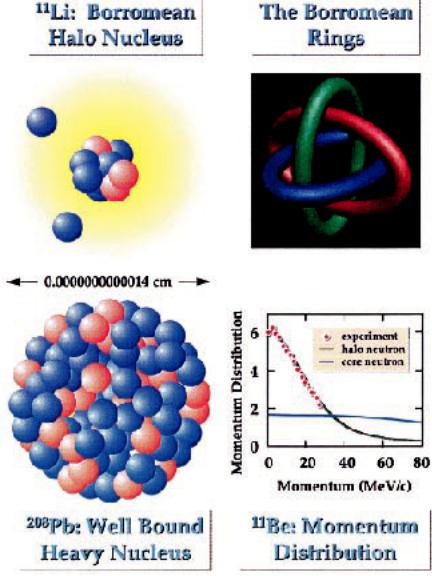
Nuclear Physics: The Core of Matter, The Fuel of Stars
http://www.nap.edu/catalog/6288.html
66 |
NUCLEAR PHYSICS: THE CORE OF MATTER, THE FUEL OF STARS |
Copyright © National Academy of Sciences. All rights reserved.
Nuclear Physics: The Core of Matter, The Fuel of Stars
http://www.nap.edu/catalog/6288.html
THE STRUCTURE OF NUCLEI |
67 |
While most of our knowledge of nuclei is limited to the neighborhood of the valley of stability, early experiments on far unstable nuclei have already revealed surprises. New phenomena such as halo nuclei—with regions of nearly pure neutron matter—and growing evidence of the fragility of shell structure far from the valley of stability are just two examples. It is becoming increasingly clear that some of the cherished concepts of nuclear structure may apply only to the set of relatively stable nuclei. The advent of radioactive ion beams offers a tool to attack the basic questions pertaining to the behavior of nucleonic matter—its binding, its dynamics, and its phases.
Limits of Angular Momentum
In spite of the fact that the number of nucleons in the nucleus is rather small, and nucleonic velocities are fast, protons and neutrons can organize themselves into states exhibiting collective motion, such as rotations or vibrations. Nuclear collective rotation is uniquely interesting due to the presence of both shell structure and superconductivity.
Many nuclei emit photons characteristic of the sequential de-excitation of excited states within rotational bands. The energy levels within such a band appear to share a common intrinsic distribution of nucleons, but differ from one another in having different degrees of collective rotation. In quantum mechanics, such collective rotation can arise for systems that have a deformed shape; the characteristics of the photons emitted by the rotating nucleus provide insight into the shape and structure of nuclei, as illustrated in Figure 3.5. Some of the exciting recent discoveries in nuclear structure are associated with such rotational
FIGURE 3.3 Loosely bound halo nuclei such as lithium-11 and beryllium-11 are unique few-body systems. A paradigm of the unexpected phenomena and unusual topologies that may occur in the vicinity of the neutron drip line is the nucleus 11Li (3 protons and 8 neutrons), understood as a three-body halo consisting of two neutrons and a well-bound 9Li core. Interestingly, while all three constituents of 11Li form a bound system when placed together, the nuclear potential is not strong enough to bind any two of them separately; hence, the name borromean nuclei. (This name comes from the Borromeo family of Renaissance Italy, whose family coat of arms pictured three rings interlocking in such a way that removing any one ring would cause all three to fall apart). Because of very weak binding, the last neutrons in lithium-11 occupy the same volume of space as the 208 nucleons in lead. Bound neutrons are not permitted to go far away from the nuclear core, by classical laws of motion; the halo structure occurs by grace of quantum mechanics. The existence of halo structure in beryllium-11 has been deduced experimentally at the Michigan State University National Superconducting Cyclotron Laboratory by studying the momentum distribution of the most weakly bound neutron (shown in the lower right of the figure). Compared to that for the well-bound neutron belonging to the beryllium-10 core, this distribution is exceptionally narrow, as expected from the Heisenberg uncertainty principle for a particle occupying an extended volume in space.
Copyright © National Academy of Sciences. All rights reserved.
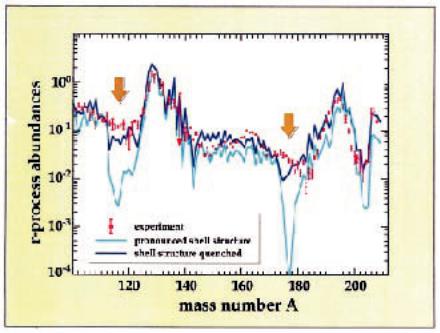
Nuclear Physics: The Core of Matter, The Fuel of Stars
http://www.nap.edu/catalog/6288.html
68 |
NUCLEAR PHYSICS: THE CORE OF MATTER, THE FUEL OF STARS |
FIGURE 3.4 The structure of nuclei is expected to change significantly as the limit of nuclear stability is approached in neutron excess. Both the systematic variation in the shell model potential and the increased role of superconducting correlations give rise, theoretically, to the quenched neutron shell structure, characterized by a more uniform distribution of levels with dramatically reduced shell gaps. An important aspect of this shell quenching is its influence on astrophysical processes and on stellar nucleosynthesis. Very neutron-rich nuclei cannot be reached experimentally under present laboratory conditions. On the other hand, these systems are the building blocks of the astrophysical process of rapid neutron capture (the r-process, see Chapter 5); their separation energies, decay rates, and neutron capture cross sections are the basic quantities determining the elemental and isotopic abundances in nature. Consequently, one can actually hope to learn about properties of very neutron-rich systems by inverting the problem and studying the r-process component of the solar system abundances of heavy elements. The black squares with error bars indicate the observed r-process abundances for nuclei with mass numbers greater than A = 100. The theoretical abundances, marked by red and blue, were obtained in the recent r-process network calculations. They are based on models that assume that the spherical shell effects towards the neutron drip line are either similar to those in stable nuclei (red curve) or significantly reduced (blue curve). It is seen that a quenching of magic gaps at N = 82 and N = 126 can lead to a dramatic increase in the calculated abundances of nuclei around A = 118 and 176, in better agreement with the data. (Adapted from Bernd Pfeiffer et al., Zeitschrift für Physik A357, 253, 1997.)
Copyright © National Academy of Sciences. All rights reserved.
Nuclear Physics: The Core of Matter, The Fuel of Stars
http://www.nap.edu/catalog/6288.html
THE STRUCTURE OF NUCLEI |
69 |
bands indicating very elongated, superdeformed shapes having the longer axis twice as long as the shorter (see Box 3.3). This simple 2:1 ratio gives rise to a set of magic numbers that are different from those in spherical nuclei, and their existence is necessary for the stability of the observed superdeformed states. There is an ongoing search for even more deformed, hyperdeformed states with a 3:1 axis ratio, which are expected at the largest spins (just before the nucleus breaks up).
In a state of a very high angular momentum, the nucleus behaves like a solid in a strong magnetic field. Hence, many magnetic phenomena may occur, similar to effects already known from condensed-matter physics. One of the main challenges for the theory of rotating nuclei is to understand the nature of the dramatic spin polarization induced by fast rotation.
The spacing of energy levels in a nucleus changes from the regular, widely spaced pattern near the ground state to the more dense and random or chaotic pattern higher up. Gamma-ray spectroscopy with the new generation of detector systems, such as Gammasphere, is a unique probe of quantum chaos, roughly defined as a regime where the pattern of quantum numbers that may be used to characterize low-lying states of a many-body system is gone. Here, the important issues under study are these: At what energy does chaos set in? What are the unique fingerprints of the transition from regular to chaotic motion? The signatures for the onset of chaos are observed not only in the distribution of energy levels, but also in the properties of electromagnetic transition intensities.
The increased precision of spectroscopic tools has allowed nuclear physicists to unveil some subtle, but startling, new phenomena:
•Identical Bands. Identical sequences of ten or more photons are observed, associated with rotational bands in different nuclei. This comes as a great surprise: it has long been believed that the gamma-ray emission spectrum for a specific nucleus represents a unique fingerprint. Explanation of these identical patterns in a wide variety of nuclei is still lacking.
•Magnetic Rotation. In nearly spherical nuclei, sequences of gamma rays are reminiscent of collective rotational bands, but with a quite different character: namely, each photon carries off only one unit of angular momentum and couples to the magnetic, rather than electric, properties of the nucleons. This is a new form of quantal rotor.
•∆I = 4 Bifurcation. Extremely small but regular fluctuations are seen in the energies of photons emitted from some superdeformed nuclei. They could be driven by quantum tunneling motion at high angular momentum.
•Band Termination. Large rotational velocities can induce a gradual shape transition from the deformed state, which can rotate to the nearly spherical configuration incapable of rotational motion. Such a “death of the rotational band” has been seen in a number of nuclei.
•Nuclear Meissner Effect. Quenching, a total disappearance of nuclear
Copyright © National Academy of Sciences. All rights reserved.
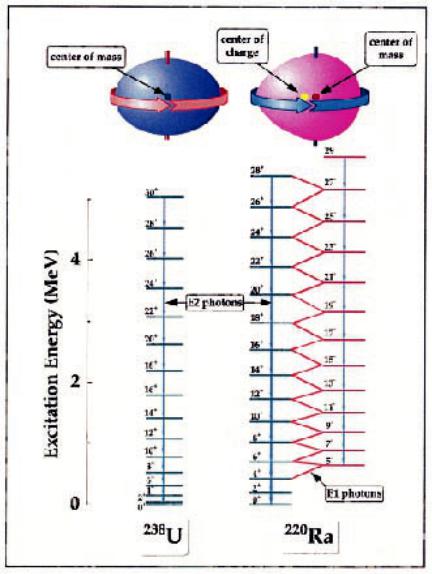
Nuclear Physics: The Core of Matter, The Fuel of Stars
http://www.nap.edu/catalog/6288.html
70 |
NUCLEAR PHYSICS: THE CORE OF MATTER, THE FUEL OF STARS |
Copyright © National Academy of Sciences. All rights reserved.
Nuclear Physics: The Core of Matter, The Fuel of Stars
http://www.nap.edu/catalog/6288.html
THE STRUCTURE OF NUCLEI |
71 |
superconductivity, is observed at high rotational frequencies. The angular momentum behaves like an external magnetic field: it tries to align the angular momenta of nucleons along the axis of rotation, and this destroys Cooper pairs of nucleons responsible for superconductivity.
• Symmetry Scars. These highly excited states, such as those in a superdeformed band, represent order in chaos. The motion in these states is ordered (i.e., it is well characterized by a number of quantum numbers). The symmetry scars are embedded in the sea of many other states that can be described in terms of chaotic motion.
Advances in high-resolution, gamma-ray detector systems are also responsible for a revolution in our studies of low-spin nuclear behavior carried out at low-energy accelerators. Here, new insights have been gained into the long unresolved, but basic, questions about the mechanisms of nuclear vibrations, about nuclear superconductivity, the statistical properties of excited nuclei, and the approximate symmetries of the many-body system. For instance, long- searched-for, vibrational multiphonon states have been discovered. The very existence of these new collective modes of nuclei, both at low and high frequencies, is intimately connected with the effects of the Pauli exclusion principle. In nuclei, nature displays the enormous diversity found in the behavior of manybody systems (see Box 3.4). Exploring this diversity in experiments, discovering its new facets, and finding effective theoretical approaches to account for them remains a continuing challenge.
FIGURE 3.5 The existence of nuclei with stable deformed shapes was known early in the history of nuclear physics. The observation of large quadrupole moments led to the suggestion that some nuclei might have spheroidal shapes, which was confirmed by observing rotational band structures and measurements of their properties. For most deformed nuclei, such as 238U, a description as an elongated sphere (i.e., a spheroid) is adequate to describe the band’s spectroscopy. Because such a shape is symmetric, all members of the rotational band will have the same parity. However, it has since been found that some nuclei might have a shape more like that of a pear, which is asymmetric under reflection. The rotational band of 220Ra consists of levels of both parities, hence the name parity doublet. Another signature of such a parity doublet is the enhanced electric-dipole radiation in 220Ra due to a nonzero electric-dipole moment. Advances in high-resolution, gamma-ray detector systems are also responsible for a revolution in our study of low-spin nuclear behavior. Here, new insights have been gained on the nature of collective nuclear vibrations. In particular, vibrational multiphonon states long searched for were found experimentally. The existence of these new collective modes, both at low and high frequencies, is intimately connected with the effects of the Pauli exclusion principle.
Copyright © National Academy of Sciences. All rights reserved.
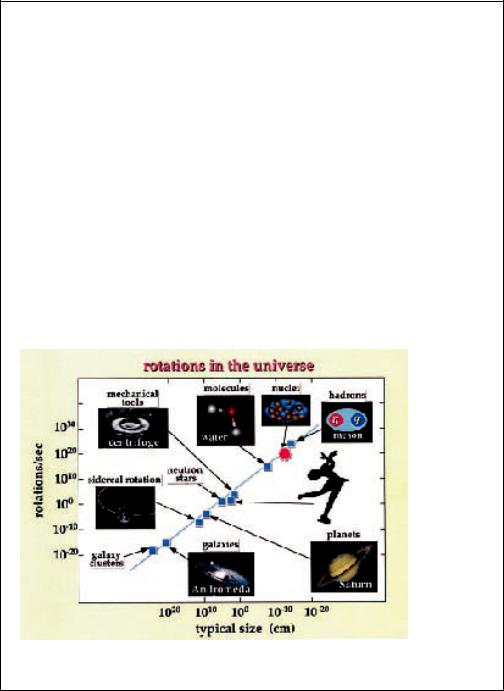
Nuclear Physics: The Core of Matter, The Fuel of Stars
http://www.nap.edu/catalog/6288.html
72 |
NUCLEAR PHYSICS: THE CORE OF MATTER, THE FUEL OF STARS |
BOX 3.3 The Champion of Fast Rotation
Rotation is a common phenomenon in nature—most objects in the universe, from the very small to the very large, rotate (Figure 3.3.1). The largest and slowest rotors are galaxy clusters. The rotation of the Andromeda Galaxy, the nearest major galaxy to our Milky Way, can be inferred from its giant spiral-shaped disk containing some hundred billion stars. Saturn is an excellent example of a deformed oblate (flattened sphere) rotator; its shape deformation is caused by a large centrifugal force. Among stellar bodies, pulsars are by far the fastest rotors; the Crab pulsar makes one revolution every 0.033 seconds! Among the dizziest mechanical man-made objects are ultracentrifuges used for isotope separation.
With some modifications, the concept of rotation can be applied to small microscopic systems, such as molecules, nuclei, and even hadrons, viewed as quarkgluon systems. Atomic nuclei, with their typical dimensions of several femtometers and rotation periods ranging from 10–20 to 10–21 sec, are among the giddiest systems in nature. What makes the nuclear rotation special and interesting are quantal effects due to the nuclear shell structure and superconducting correlations.
Most rotating celestial bodies show a common behavior: at low angular momenta they acquire axial shapes depressed at the poles, like our Earth or Saturn, but at sufficiently rapid rotation, a shape transition to ellipsoidal forms having three different axes takes place. At even faster rotations, the body becomes so elongat-
FIGURE 3.3.1
Copyright © National Academy of Sciences. All rights reserved.
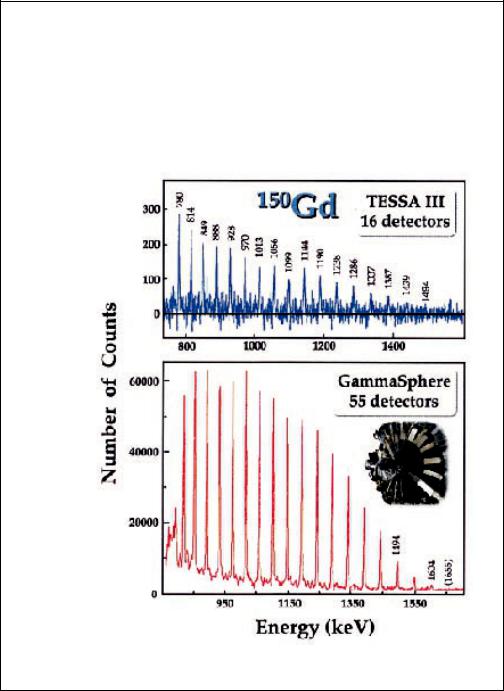
Nuclear Physics: The Core of Matter, The Fuel of Stars
http://www.nap.edu/catalog/6288.html
THE STRUCTURE OF NUCLEI |
73 |
ed that it fissions into two fragments. Interestingly, the shape changes found in hot nuclei, where the shell effects and superconductivity can be ignored, seem to resemble this behavior.
The best nuclear rotators have elongated shapes resembling a football. The signature for such superdeformed states is a “picket fence” spectrum of gamma rays. The experimental spectrum of superdeformed 150Gd shown in the upper part of Figure 3.3.2 was obtained in 1989 in England. The bottom, much improved, spectrum was taken at the Lawrence Berkeley National Laboratory using the newgeneration, germanium-array Gammasphere with 55 detectors. The increased precision of experimental tools of gamma-ray spectroscopy has made it possible to probe new effects on the scale of a 1/100,000 of the transition energies.
FIGURE 3.3.2
Copyright © National Academy of Sciences. All rights reserved.
